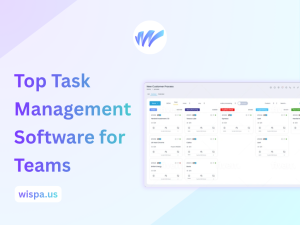
Best Free Workflow Management Software for Teams in 2025
Every business, whether a growing startup, a small consulting firm, or a team of freelancers, shares a common struggle-how to keep work organized without losing momentum. In 2025, this challenge is sharper than ever. Teams are more distributed, projects are more complex, and deadlines are tighter. Workflow efficiency is now a survival factor.
For years, businesses relied on emails, spreadsheets, or endless meetings to coordinate tasks. While these methods worked in fragmented ways, they created duplication, miscommunication, and wasted hours. The introduction of workflow management software changed this by offering a centralized hub where tasks, responsibilities, communication, and deadlines live in one place.
But budget is often a barrier. Not every team can invest in premium enterprise tools. Thankfully, there are some best free workflow management software that allows smaller organizations the same clarity, accountability, and speed as larger enterprises, without the cost.
What is Workflow Management Software?
Imagine a team juggling multiple client projects. One member tracks deadlines in Excel, another shares updates via WhatsApp, while someone else relies on email reminders. Each tool works in isolation, but together they create confusion. Campaign briefs get lost in chat threads, deadlines slip unnoticed in spreadsheets, and important approvals hide in overflowing inboxes. This often results in missed deadlines, duplicated work, and mounting frustration.
This is where workflow management software changes everything.
workflow management software is a digital system that helps teams plan, organize, and monitor their workflows. It eliminates silos by consolidating communication, task assignment, progress tracking, and reporting into one unified platform.

Whether it’s tracking marketing campaigns, coordinating product development, or managing HR onboarding, the platform becomes a unified command center for execution.
Unlike simple to-do lists, workflow software is about building an operational framework where collaboration becomes natural and progress is transparent. It transforms scattered activities into a living ecosystem where every task is mapped, every dependency is visible, and bottlenecks can be spotted before they become costly delays.
Its core functions include:
1. Breaking projects into actionable tasks with ownership
Example: In a software team, instead of saying “Build new login feature,” workflow software creates subtasks like “Design UI mockups,” “Code authentication module,” and “Run QA testing”- each assigned to the right person.
2. Creating visibility for stakeholders
Example: A project manager overseeing a construction project can open the dashboard and instantly see which tasks are “In Progress,” which are “Blocked,” and which are “Completed.” No need for status-chasing emails.
3. Reducing bottlenecks with automation
Example: In a sales process, when a lead moves from “Qualified” to “Proposal Sent,” the software can automatically assign a follow-up task to the sales rep and send a reminder before the due date.
4. Enhancing collaboration by centralizing updates
Example: Instead of sharing design files across email threads, a creative team can upload the file within the task, add comments, and tag team members directly for feedback.
5. Driving accountability with reminders and progress indicators
Example: In HR onboarding, when a new employee joins, tasks like “Set up email ID,” “Create payroll account,” and “Schedule orientation” are automatically assigned with due dates and notifications, ensuring nothing is missed.
Core Functions of Workflow Management Software
From Chaos to Clarity
- Breaks down projects into tasks – ensures every step has an owner.
- Creates real-time visibility – stakeholders always know what’s on track or blocked.
- Reduces bottlenecks with automation – repetitive steps get handled automatically.
- Centralizes collaboration – files, comments, and updates live in one place.
- Drives accountability – deadlines, reminders, and progress tracking keep work moving.
With a suitable workflow management software, your team gets a command center where ideas turn into execution.
Key Features to Look for in Free Workflow Management Software
Not all free tools are created equal. While some provide robust task-tracking, others excel at collaboration or integrations. Here are the must-have features to evaluate:
1. Task Management
The backbone of any workflow tool. A robust platform should allow you to:
- Create and assign tasks easily.
- Set due dates and priorities.
- Track progress through stages like “To Do → In Progress → Completed.”
A good tool should support multiple views (list, board, calendar) so teams can choose formats that fit their style.
2. Collaboration Tools
Teamwork requires more than tasks, it needs communication. Look for:
- In-app chat, mentions, or threaded comments.
- File sharing within tasks.
- Real-time notifications to keep everyone aligned.
3. Automation
Repetition is the enemy of productivity. Tools with automation workflows allow you to:
- Auto-assign tasks when a project stage changes.
- Send reminders before deadlines.
- Trigger status updates when conditions are met.
4. Reporting and Analytics
Without measurement, optimization isn’t possible. The tool should provide:
- Dashboards for team productivity.
- Reports on task completion rates and missed deadlines.
- Insights to identify process inefficiencies.
When choosing free software, balance these features against what your team truly needs at its current stage.
Benefits of Using Free Workflow Management Software

The instinct may be to purchase premium software immediately. However, starting with free workflow management tools offers significant advantages, especially for small and growing teams.
Cost-Effectiveness
For startups and small businesses, every dollar counts. Free software provides a foundation to organize workflows without draining budgets, leaving resources for other priorities like marketing, hiring, or product development.
Accessibility and Ease of Use
Free tools are typically cloud-based and designed with user-friendliness in mind. Unlike legacy enterprise systems, they don’t require IT support or weeks of training. Teams can sign up and get started the same day.
Scalability
Most free tools also act as a launchpad. As your team grows, you can upgrade to premium plans that expand functionality, making them long-term solutions rather than temporary fixes.
This balance of cost, accessibility, and scalability is why free workflow software has become the default entry point for businesses in 2025.
Top 8 Free Workflow Management Software in 2025
Here’s a breakdown of the leading free platforms, their standout features, and best-fit use cases.
1. Wispa – Modern, lightweight workflow tool built for distributed teams.
2. Asana – Structured task management with clear accountability.
3. ClickUp – Feature-rich all-in-one platform for complex projects.
4. Monday.com – Highly customizable boards for unique workflows.
5. Airtable – Spreadsheet–database hybrid for data-driven teams.
6. Wrike – Enterprise-style collaboration simplified for small teams.
7. Notion – Flexible workspace blending docs, wikis, and tasks.
8. Trello – Simple, visual Kanban boards for effortless task tracking.
1. Wispa – The Rising Star
Wispa is a next-gen workflow platform built for distributed, fast-scaling teams. It combines visual clarity, automation, and built-in collaboration in a lightweight package.
Unlike bloated enterprise tools, Wispa focuses on speed and simplicity while still offering advanced workflows, integrations, and a mobile-first design, making it a modern solution for startups and SMEs looking to grow without friction.
Key Features:
- Drag-and-drop boards (Kanban, List, Timeline).
- Native chat, mentions, and threaded comments.
- Automation workflows for repetitive tasks.
- Integrations with Slack, Google Drive, Microsoft 365.
- Mobile-friendly UI for remote and hybrid teams.
Best Fit: Startups, small-to-mid businesses, and design-oriented teams seeking simplicity with power.
Limitation: Still a newer platform- ecosystem of integrations is growing compared to mature competitors.
2. Asana – The Structure Expert
Asana is one of the most established workflow management tools, designed around task clarity, structured project ownership, and visibility. It is known for handling both simple task lists and complex multi-step projects.
The free plan supports up to 10 users, making it ideal for teams who want disciplined, rule-based management without paying upfront.
Free Plan Features:
- Unlimited tasks, projects, and activity logs.
- Views: List, Kanban board, Calendar.
- Task dependencies for sequencing.
- Commenting, tagging, and file attachments.
Best Fit: Small teams seeking structured accountability and clear ownership.
Limitation: Free plan lacks advanced reporting and team dashboards.
3. ClickUp – The Feature Powerhouse
ClickUp is known as the all-in-one project operating system, packing more features into its free plan than most competitors offer in premium tiers. It supports multiple views, time tracking, docs, goals, and extensive integrations.
Its flexibility appeals to teams who want one platform for everything, from project planning to documentation to analytics.
Key Features:
- Multiple views (List, Kanban, Gantt, Calendar, Mind Map).
- Native time tracking & goal-setting.
- Custom fields and dashboards.
- 100MB storage in free plan.
- 1,000+ integrations (Slack, Zoom, Zapier, GitHub).
Best Fit: Agencies, tech startups, and teams managing client deliverables.
Limitation: Feature overload can intimidate small or non-technical teams.
4. Monday.com (Free Plan) – The Customizer
Monday.com is a flexible work OS that adapts to non-standard workflows like sales pipelines, HR onboarding, or creative approvals. Its grid-based boards can be customized heavily, making it ideal for teams that don’t fit into rigid task management formats.
The free plan, however, is capped at just two seats, useful for freelancers or very small teams.
Free Plan Feature
- Unlimited boards and docs.
- Pre-built templates for operations, marketing, HR.
- Comments, updates, and file attachments.
- Integrations with Gmail, Outlook, Zoom.
Best Fit: Micro-teams and freelancers with specialized workflows.
Limitation: 2-user limit makes it impractical for growing teams.
5. Airtable – The Data-Driven Choice
Airtable is a spreadsheet-database hybrid that blends project tracking with structured data management. It is highly customizable, making it popular for content teams, product managers, and inventory tracking. Its modular design allows building everything from editorial calendars to lightweight CRMs.
Airtable stands out for users who need flexibility in organizing large datasets alongside workflow processes.
Key Features:
- Views: Grid, Kanban, Calendar, Gallery.
- Filtering, grouping, and relational database linking.
- 1,200 records and 2GB attachments per base (free).
- Templates for CRM, content, product roadmaps.
- Automations via Airtable Automations and Zapier.
Best Fit: Teams working with structured datasets (e.g., content planning, logistics, inventory).
Limitation: Storage and record limits restrict large-scale operations.
6. Wrike (Free Plan) – The Enterprise Lite
Wrike is a work management platform built for enterprises, but its free plan provides a simplified version for small teams. It focuses on collaboration, activity tracking, and real-time updates.
While lacking premium-level enterprise features like Gantt charts and advanced reporting, Wrike’s free plan is polished enough to serve as a secure entry point for remote teams.
Key Features:
- Task & subtask management.
- Real-time activity streams.
- File sharing and in-task discussions.
- Free for up to 5 users.
Best Fit: Small, remote teams requiring a reliable collaborative hub.
Limitation: Advanced project planning tools locked behind paid tiers.
7. Notion – The Workspace Ecosystem
Notion is more than a workflow tool, it’s a workspace that blends documents, wikis, and task tracking. Its modular block system makes it incredibly versatile, allowing teams to build anything from project boards to knowledge libraries.
While it lacks deep automation, Notion’s value lies in combining knowledge management and workflow into a single ecosystem.
Key Features:
- Modular blocks for custom layouts.
- Real-time multi-user editing.
- Templates for personal & team use.
- Integrates notes, docs, tasks, and databases.
Best Fit: Teams that want workflows and documentation under one roof.
Limitation: Limited automation and reporting features compared to dedicated project managers.
8. Trello – The Simplicity King
Trello pioneered Kanban boards and remains one of the most user-friendly project tools. It is perfect for small teams or individuals who want an intuitive, visual way to manage tasks.
While it lacks advanced features by default, its Power-Ups extend functionality with calendars, integrations, and automation, making it a simple yet flexible starting point.
Free Plan Features:
- Unlimited cards, 10 boards per workspace.
- Drag-and-drop Kanban interface.
- Power-Ups for integrations (Slack, Google Drive, etc.).
- Mobile-friendly apps for quick updates.
Best Fit: Beginners, freelancers, and teams wanting simple visual workflows.
Limitation: Timeline, calendar, and advanced reporting require upgrades.
How to Choose the Right Workflow Management Software
With so many options, the question becomes: how do you know which one fits your team?
1. Assess Your Needs
Understand your team’s current size, type of projects, and critical requirements. Content planning vs. software development requires different strengths. A small content team may prioritize collaboration, while a product development team may prioritize automation.
2. Compare Features
Stack tools side by side and evaluate.Focus on:
- Task tracking flexibility.
- Collaboration features.
- Integration with tools you already use.
3. Test Before Committing
Since these are free tools, try them out. Hands-on experience is the best way to know if the software feels natural for your team.
Conclusion
The real value of workflow software comes when teams build habits around it. A quick daily check-in, updating tasks, reviewing blockers, aligning priorities, keeps the tool alive and accurate. Remember, the best platform won’t boost productivity unless your team uses it consistently.
Ready to see how this works in action? Try Wispa today and experience workflow clarity without the cost.
Frequently Asked Questions
Trello and Asana are great for beginners. But if you’re thinking about long-term scalability, Wispa is an excellent choice.
Yes. Most reputable providers offer encryption and secure cloud storage. Always verify policies before storing sensitive data.
Yes, though with some limits. For example, ClickUp and Monday.com can manage complex projects even on free tiers, but advanced automations may be locked behind paid plans.
Restricted storage, limited integrations, or user caps. These are manageable at the startup stage.
Absolutely. Once your workflow becomes more complex, premium tiers unlock advanced reporting, deeper automations, and expanded storage.




